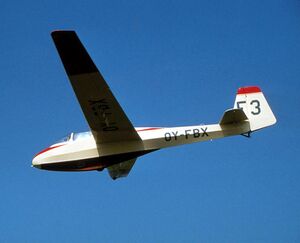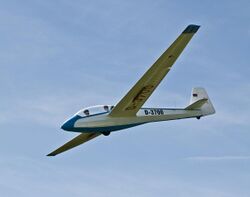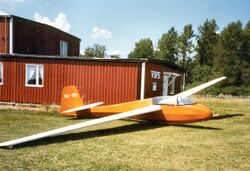Engineering:Scheibe Bergfalke
| Bergfalke | |
|---|---|

| |
| Scheibe Bergfalke III | |
| Role | Sailplane |
| National origin | Germany |
| Manufacturer | Scheibe |
| Designer | Egon Scheibe |
| First flight | 5 August 1951 |
| Number built | more than 320 by 1982 |
| Developed from | Akaflieg München Mü13 |
The Scheibe Bergfalke (German: "mountain hawk") is a German glider designed by Egon Scheibe as a post-World War II development of the Akaflieg München Mü13 produced before and during the war.
Design and development
The prototype flew on 5 August 1951 as the Akaflieg München Mü13E Bergfalke I and by the end of the year, Scheibe had established his own works at the Munich-Riem Airport to produce the type as the Bergfalke II.[1] It was a mid-wing sailplane of conventional design with a non-retractable monowheel undercarriage and a tailskid.[2] The fuselage was a welded steel structure covered in fabric and enclosed two seats in tandem.[2] The wings had a single wooden spar and were covered in plywood.[2]
Subsequent versions introduced forward sweep to the wings, a more aerodynamic canopy, airbrakes, and a tailwheel in place of the tailskid.[1] By 1982, Scheibe had built over 300 of these aircraft, and Stark Ibérica built a number of the Bergfalke III version under license in Spain.[1] Scheibe also developed a motorglider version as the Bergfalke IVM[1] but this did not enter production.[2]
In 1976, two Bergfalke motorgliders participated in the Sixth German Motor Glider Competition. Later, one of these aircraft set a world 300 km triangle record.[3]
Variants
- Mü13E Bergfalke I
- Prototype
- Bergfalke II
- First production version, 4° forward sweep on wings[1]
- Bergfalke II/55
- Skopil Bergfalke II/55
- Motorglider conversion done by Arnold Skopil of Aberdeen, Washington, United States in 1957. One converted.[4][5]
- Bergfalke III
- Streamlined canopy, taller fin and rudder, Schempp-Hirth airbrakes, 2° forward sweep on wings[1]
- Bergfalke IV
- Wing of Wortmann section with 60-cm (2-ft) greater span[1]
- Bergfalke IVM
- Motorglider version with 39-kW (52-hp) Hirth O-28 engine mounted on retractable pylon behind cockpit.[1]
Specifications (Bergfalke II/55)
Data from The World's Sailplanes:Die Segelflugzeuge der Welt:Les Planeurs du Monde [2][6]
General characteristics
- Crew: 2
- Length: 8 m (26 ft 3 in)
- Wingspan: 16.6 m (54 ft 6 in)
- Wing area: 17.7 m2 (191 sq ft)
- Aspect ratio: 15.6
- Airfoil: Mü-Profil 14.5%
- Empty weight: 246 kg (542 lb)
- Max takeoff weight: 440 kg (970 lb)
Performance
- Stall speed: 60 km/h (37 mph, 32 kn)
- Never exceed speed: 160 km/h (99 mph, 86 kn)
- Rough air speed max: 120 km/h (75 mph; 65 kn)
- Aerotow speed: 120 km/h (75 mph; 65 kn)
- Winch launch max speed: 85 km/h (53 mph; 46 kn)
- Terminal velocity: 205 km/h (127 mph; 111 kn) (max all-up weight + full airbrakes / flaps)
- g limits: +4 -2
- Maximum glide ratio: 28:1 at 80 km/h (50 mph; 43 kn)
- Rate of sink: 0.72 m/s (142 ft/min) at 72 km/h (45 mph; 39 kn)
- Wing loading: 24.8 kg/m2 (5.1 lb/sq ft)
See also
Aircraft of comparable role, configuration and era
- Schleicher K13
Notes
- ↑ 1.0 1.1 1.2 1.3 1.4 1.5 1.6 1.7 Hardy, Michael (1982). Gliders and Sailplanes of the World. Shepperton: Ian Allan. pp. 79–80.
- ↑ 2.0 2.1 2.2 2.3 2.4 Taylor, John W. R. (1977). Jane's All the World's Aircraft 1977–78. London: Jane's Yearbooks. pp. 528 & 594.
- ↑ Coates, Andrew (1978). Jane's World Sailplanes and Motor Gliders. London: MacDonald and Jane's. pp. 67.
- ↑ Said, Bob: 1983 Sailplane Directory, Soaring Magazine, page 131. Soaring Society of America, November 1983. USPS 499-920
- ↑ Activate Media (2006). "Bergfalke Scheibe". Archived from the original on 19 November 2002. https://web.archive.org/web/20021119184418/http://www.sailplanedirectory.com/PlaneDetails.cfm?planeID=38. Retrieved 30 July 2011.
- ↑ Shenstone, B.S.; K.G. Wilkinson (1958) (in English, French, German). The World's Sailplanes:Die Segelflugzeuge der Welt:Les Planeurs du Monde (1st ed.). Zurich: Organisation Scientifique et Technique Internationale du Vol a Voile (OSTIV) and Schweizer Aero-Revue. pp. 73–80.
References
- Shenstone, B.S.; K.G. Wilkinson (1958) (in English, French, German). The World's Sailplanes:Die Segelflugzeuge der Welt:Les Planeurs du Monde (1st ed.). Zurich: Organisation Scientifique et Technique Internationale du Vol a Voile (OSTIV) and Schweizer Aero-Revue. pp. 73–80.
- Coates, Andrew (1978). Jane's World Sailplanes and Motor Gliders. London: MacDonald and Jane's. pp. 67.
- Hardy, Michael (1982). Gliders and Sailplanes of the World. Shepperton: Ian Allan. pp. 79–80.
- Taylor, John W. R. (1977). Jane's All the World's Aircraft 1977–78. London: Jane's Yearbooks. pp. 528.
- Taylor, Michael J. H. (1989). Jane's Encyclopedia of Aviation. London: Studio Editions. pp. 793.
External links
 |



